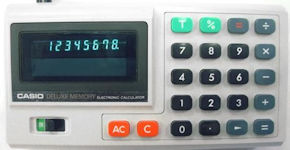
|
AKA: DELUXE MEMORY ELECTRONIC CALCULATOR, AKA (Label): DELUXE MEMORY, Product number (P/N): Deluxe Memory,
Keywords/Tags: Deluxe Memory | DELUXE MEMORY ELECTRONIC CALCULATOR
Date of intro: 1974, Origin: Japan (List), Dimensions: 156x82x30mm, Weight: 186g,
Power: 6V: (AA x4) + Adaptor, Adaptor: CASIO_adaptors: AD4145,
Display: Type = Display (VFD) (List), Brand = LD8105,
Number of keys: 22,
Classification: / Pocket,
Featuring: Procent, Logic-technology: VLSI (Very Large Scale Integration), calculator-on-a-Chip,
Related with: CASIO_docu: S300-1047B (Broch.) Deluxe Memory; CASIO_docu: (Ad.) *: Die neue CASIO-MINI Generation; CASIO_docu: M3000357E (Broch.) *: 101MR,801MR,C100P,CD812,CM606,CP802,...,
Main Components: NEC: µPD970C,
Resemblance with: (Resemblance 095),
Known Serial-numbers: 3152882 (List of all S/Ns from CASIO)
Initial Cost Price: 12�800 JPY ( 103,68), Collector value: 7/10,
Info: DUDEK Emil:
Case:
Horizontal format two-piece case in black and white smooth plastic. The display escutcheon in black plastic set in its own recess, flush and tilted.
A further inset panel has printed model number and reversed out Casio name on a metallic sticker.
Large, long travel hollow sounding keys work well and a deep cut groove (read dirt collection area) outlines the key area.
A slightly inset neutral display filter gives a bright display with odd "small zero" notation.
Comments:
One of a range of early, solidly built horizontal calculators by Casio very similar to the later Casio Mini Memory.
This one benefits from an eight digit display but strangely keeps the shift key. Logic is let down by unrecoverable errors, divide by zero and quirky memory system.
Boards:
The keyboard assembly (ref D8Z-E4-1 B) sits lose on top of the battery compartment and is joined to the main board (ref D8Z-1C LD8105) by 12 stiff wires.
The former is L-shaped to avoid the battery compartment. The whole assembly sits lose in the case.
Construction:
Remove the single screw on the right-hand side and very gently squeeze in the black section to release the lugs one by one. Not for the faint hearted - so do not attempt if you want to keep the calculator pristine.
The front will lift off but the lower left-hand edge can be really tricky as the lug butts onto the board.
Logic comments:
The [C] button is used to clear last entry of a number and the [AC] to clear the whole calculator.
Overflow on number input is suppressed, typing in a seven digit number ignores the seventh digit.
An overflow error is flagged with the answer displayed and viewable using the shift key (>) and is not recoverable.
Divide by zero error is ignored and calculation can continue with the zero result.
There is automatic constant on multiply and divide only.
To add to the memory switch to T-mode and every [=] signs adds to the memory. To subtract from the memory, use the red [=] key.
[AC] clears the memory and there is no indication - you have to remember it.
Negative numbers are shown by a - in the immediate left digit. A result which is eight digits long and negative results in an unrecoverable error, but you can see the answer by use of the shift [>] key.
It suffers the negative zero bug: key in [1][-][2][=] to give -1 now [+][1][=] to give -0
It suffers the divide to negative zero bug: key in [0][-][1][=] to give -1 which shows the extra internal digit of precision] now [/][1][0][=][=][=] etc.
until you get -0.000000 then [=] will give -0
Internet: Link-1: LEDUDU, Link-2: CASIO CALCULATOR COLLECTORS
!!! This item is WANTED to join the collection !!!
|
| Item |

















